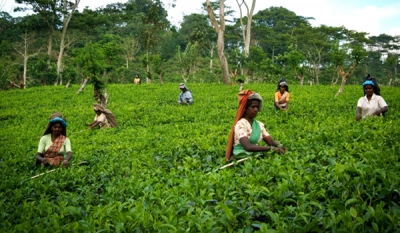By end of 2014, on average RPCs were making a loss of approximately Rs. 30 on each kilogramme of tea sold, with average cost of production at Rs. 455 with Net Sales Average at just Rs. 425.
In the case of rubber, the other main crop cultivated by most RPCs, the loss on each kilogramme was even higher at Rs. 35, with average cost of production at Rs. 327 but Net Sales Average at only Rs. 292.
The situation is now aggravated leading to further accumulation of losses with the average tea prices declining sharply at the Colombo Tea Auction within the first two months of 2015.
Prices have slumped below corresponding levels in 2014, despite the increased cost of production since then.
The auction average at the Colombo Tea Auction for February 2015 was only Rs. 418 – a Rs. 64 reduction from Rs. 482 in February 2014 and even below Rs. 423 which prevailed in February 2013.
Some RPC estates are now thus incurring a loss in the excess of Rs. 50 per kilogramme of tea sold.
“Due to external factors, the market for tea is very challenging at present and most worryingly, the situation appears to be a trend rather than a phase of a cycle,” Roshan Rajadurai, Chairman of the Planters’ Association of Ceylon – which represents the Regional Plantation Companies (RPCs) said.
“Tea is available the world over at Tea Producing Auction Centres at around USD 2/- a kilogramme and therefore tea traders tend to buy cheaper teas from these origins because of the cash flow and liquidity problems they themselves face.
Our tea prices are in the range of USD 3/- and above.
In this scenario, the immediate survival and by extension the sustenance of the over one million population resident in our estates are facing a great danger, as we are finding it extremely difficult to manage our day-to-day operations and commitments.”
“All must support productivity improvements, without which the industry’s downhill spiral is irreversible and as we have always maintained, the future sustenance and the survival of the industry to a great degree is in the hands of the workers themselves.
They can easily increase the daily output and support cost reduction so that we can be competitive in the world markets, as our costs are the highest in the world on account of our labour productivity being the lowest in the world,” he reiterated pointing out that according to the estimates of the RPCs, a one Rupee increase in labour wages will automatically increase the cost of production of tea by 52 cents per kilogramme.
“Therefore there is no choice left but for all the stakeholders to work in unison to save the industry and the people involved, realising the current external pressures and challenges.”
With the demand hitting a historic low, buyers are now purchasing lower quality tea at lower prices, thereby creating additional woes for the RPCs.
Large quantities of teas remain unsold at the weekly Colombo Tea Auctions and the RPCs are forced to increase the borrowings in order to pay the wages and other commitments to the workers and to keep the cash flow intact due to delays in receiving incomes for shipments, Rajadurai further noted.
“Being mandated to provide 25 days of work to our workers, our cost of production is significantly above the price (NSA) that we are receiving at the moment for rubber,” Lankem Tea and Rubber Plantations CEO, Ranjit Peries said. “Based on forecasts, prices will not increase within this year.”
“The depressed auction prices of tea, due to external factors, are creating much concerns for all stakeholders,” a top official of one of Sri Lanka’s foremost tea exporting companies said.
“Considering the gravity of the situation, tea traders have even appealed to the government for relief.”
Overall slump in tea prices is due to many reasons, the main being the current catastrophic situations in key markets of Russia, Middle East and Ukraine that account for over 70% of exports of Ceylon Tea.
The downturn in the Middle East following drastic reduction in oil prices, a raging military conflict in Ukraine and economic sanctions in Russia as well as the recent depreciation of its currency, have created an almost impossible to recover situation for Ceylon Tea.
With the global rubber market in a slump and prices not expected to recover soon, a double whammy situation has emerged.
Rubber losses too have spiralled and some RPCs are now on average incurring a loss of around Rs. 70 per kilogramme of rubber sold.
Lesser demand from China, a major buyer of natural rubber from Sri Lanka, due to economic slowdown and reduction in price of synthetic rubber, a substitute, following fall in petroleum prices are among the key factors making an adverse impact on local rubber prices.
The issues in export markets add to the longstanding concerns regarding high costs of production, particularly in tea, for which Sri Lanka has the highest production costs in the world, while other factors including weather are also not conducive at the moment – hectares of tea fields were damaged due to frost recently.
In this scenario, the need for greater productivity to reduce labour costs and thus total cost of production appears to be the consensus among the RPCs.
In tea, the unit labour cost alone in Sri Lanka (which is approximately 67% to 70% of the total) is higher than the entire unit cost of production of some of its competitors.
Substantially lower labour productivity, even after making allowance for lower land productivity, continues to pose a major issue. At approximately 18kg, the daily plucking average of a Sri Lankan worker is less than half of that of a South Indian plucker (38kg) and is slightly more than a third of that of a Kenyan plucker (48kg).
The RPCs thus urge all stakeholders to support improvements in productivity, to ensure the survival of the plantation sector and its approximately 200,000 direct employees and many more dependants.



























